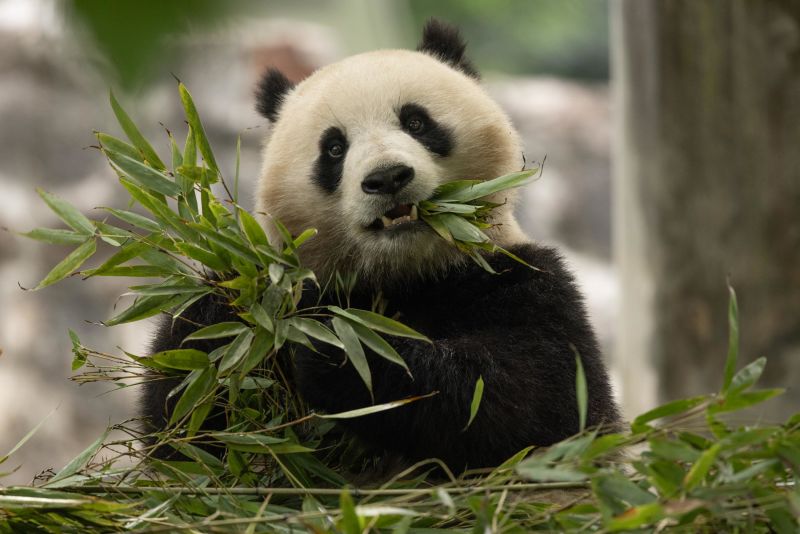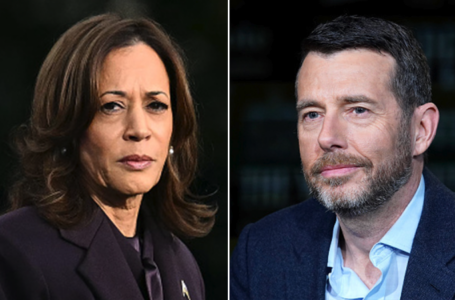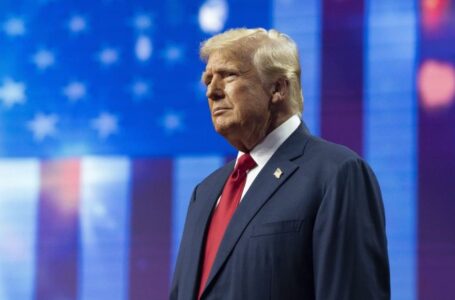Ceasefire brings ‘unusual’ calm for northern Israelis, but fears of Hezbollah threats persist
They’re cute, cuddly and coming to America: China’s newest panda diplomats headed for Washington


Two giant pandas are on their way from China to Washington’s National Zoo, kicking off a much-awaited return of the beloved bears to the American capital.
Bao Li and Qing Bao, both three years old, left the giant panda research base in Dujiangyan, a city near the bears’ native habitat in the mountains of southwest China, on Monday night local time. They will board a specially charted FedEx Boeing 777 cargo jet dubbed the “Panda Express” and take off for Washington in a few hours.
“We have prepared corn buns, bamboo shoots, carrots, water, and medicine to ensure the pandas’ needs are met during the flight,” the China Wildlife Conservation Association said in a statement announcing the pair’s departure.
The black and white bears are the first pair China has sent to Washington in 24 years. The previous pair returned to China with their cub last November, triggering a flood of tearful goodbyes at the Smithsonian’s National Zoo.
Over the past 11 months, the zoo’s panda exhibit, which used to draw millions of visitors, has been left empty. Now, having just completed a million-dollar revamp, it’s counting down the hours to welcome the new tenants.
China’s renewed panda diplomacy with the US is a rare bright spot in the fraught relations between the world’s two superpower rivals – which have been marred by tensions over trade, technology, geopolitics and more.
The male, Bao Li, appeared calm and composed as he slowly paced around the crate. Qing Bao, a petite female, was more restless. She stood up and stuck her snout and paws out through the bars as her crate was forklifted onto the truck.
Staff members waved photos of the two bears and banners as the trucks drove by, chanting slogans wishing them a safe journey.
A sendoff ceremony was held earlier on Monday at a hotel near the base, joined by a delegation from the Washington zoo who came to the Chinese province of Sichuan to help with the transition.
Speaking at the ceremony, the zoo’s director, Brandie Smith, hailed half a century of collaboration between the Smithsonian and its Chinese partners on panda conservation, since the first pair arrived from China in 1972.
“These beloved black and white bears are icons in Washington DC, and adored around the world,” Smith said. “Our team and legions of fans look forward to welcoming Bao Li and Qing Bao to the Smithsonian’s National Zoo.”
The two pandas are loaned to the Smithsonian’s National Zoo for 10 years, with an annual fee of $1 million to support conservation efforts back in China.
While born in Sichuan, Bao Li has deep familial roots in Washington. His mother, Bao Bao, was born a celebrity at the National Zoo in 2013 and returned to China four years later. His grandparents, Meixiang and Tian Tian, lived at the zoo for 23 years until their lease ended last year.
“He reminds me a lot of his grandfather, Tian Tian,” said Mariel Lally, a panda keeper from the National Zoo who is accompanying Bao Li and Qing Bao on the flight to Washington.
‘A very comfortable ride’
Much preparation has been made for the two pandas’ journey across the Pacific Ocean.
Lally spent the past 10 days at the Dujiangyan base getting to know the two pandas and working with their Chinese keepers for the transfer. Two more colleagues – a vet and another keeper – arrived from Washington last week to join the training.
Bao Li and Qing Bao were taken off public display and placed in quarantine on September 13 – a day after Qing Bao turned three years old. (Bao Li had his birthday five weeks earlier.) They were kept in separate enclosures in a fenced-off quarantine zone lined with bamboo trees, tucked in a quiet staff-only area away from the crowds of tourists.
Ren Zhijun, a Chinese keeper who has been caring for the two bears in quarantine, said he was struck by the pair’s completely different personalities.
Bao Li is energetic and has a great appetite – living up to his name, which means “precious vigor.” The female, Qing Bao, which means “green treasure,” is “lazy and loves to sleep,” Ren said. “When she wants to have some exercises, she would climb a tree.”
Ren also noticed a big difference in their appetite: Bao Li, who loves bamboo shoots, can eat twice as much bamboo as Qing Bao, who counts carrots and apples as her favorite food.
Bao Li and Qing Bao spent their last few days in Dujiangyan getting trained for their first long-haul flight. Every morning, the pair would walk into their shipping crates voluntarily as soon as the door opened – with a little help of food.
“They go in there, they get their favorite treats, and it’s actually difficult to get them out of it,” Lally said. “They’re really comfortable in there, and the crates are humongous. They could lay down in either direction, stand up, do a cartwheel – you name it, there’s so much space.”
The crates are built in a way that allows the keepers to pass bamboo, bamboo shoots, fruits and fresh water to the bears on the flight.
“[They] will have a very comfortable ride even though it’s gonna be a long ride,” Lally said.
‘A new chapter’
The Smithsonian’s National Zoo was the first in the US to exhibit the rare, cuddly animals as part of China’s “panda diplomacy” – a strategic tool to win partners, build goodwill and showcase soft power.
It all began with US President Richard Nixon’s ice-breaking trip to Communist China during the Cold War. During that historic visit in 1972, first lady Pat Nixon was reportedly charmed by the pandas at the Beijing Zoo.
Days later, when seated next to Chinese Premier Zhou Enlai at a banquet in Beijing, Pat Nixon noticed a box of cigarettes on the table decorated with pandas. “Aren’t they cute? I love them,” she told his host. “I’ll give you some,” he replied.
Weeks later, a pair of pandas, Ling Ling and Hsing Hsing, arrived at the National Zoo in Washington. “I think pandamonium is going to break out right here at the zoo,” Pat Nixon quipped at the welcome ceremony.
She was right. On their first day of public display, the two pandas drew a reported 20,000 visitors. Since then, giant pandas have become the zoo’s star attraction, drawing millions of visitors.
The zoo’s 24-hour Giant Panda Cam has garnered more than 100 million page views since its launch in 2000. It went offline last November, when Mei Xiang, Tiantian and their youngest cub Xiao Qi Ji left for China.
For many DC residents, their departure signaled the end of an era: for the first time in 23 years, the giant panda exhibit at the National Zoo had become empty.
It also stoked fears that the US might soon be without pandas. San Diego and Memphis had already returned their bears to China in recent years, and the only four remaining in Atlanta are scheduled to depart this year.
While the flurry of departures was somewhat expected as the zoos’ panda leases expired, it came at a fraught moment in relations between the US and China. Some observers wondered whether Beijing was halting “panda diplomacy” with America and instead doling out new panda loans to Europe and the Middle East.
Then, in a visit aimed at stabilizing rocky ties, Chinese leader Xi Jinping signaled in San Francisco in last November that China would be sending new panadas to the US, calling them “envoys of friendship between the Chinese and American peoples.”
A new round of “panda diplomacy” soon resumed. In June, a pair of pandas arrived at the San Diego Zoo, weeks after the National Zoo announced it would be getting two new bears by the end of the year.
Smith, the National Zoo’s director, called the upcoming arrival of Bao Li and Qing Bao a “historic moment” opening the next chapter of the zoo’s giant panda conservation program.
“Giant pandas truly represent how great conservation outcomes can be achieved through great partnerships and with public support,” she said.
But not everyone in China is happy about these new loans. A fringe but vocal group of online influencers have vehemently protested sending China’s “national treasures” to the US and other countries.
Some voiced concerns about their wellbeing, alleging without evidence that American zoos have mistreated pandas. Such claims, often fueled by nationalistic, anti-US sentiment, gained traction on Chinese social media in recent years following the controversy over the health of Ya Ya, a panda formerly at the Memphis Zoo.
When Bao Li and Qing Bao were taken into quarantine in September, the China Conservation and Research Center for Giant Panda issued a statement rebuffing rumor about the mistreatment of pandas at the Washington zoo.
“The international cooperation on giant pandas holds great significance,” the center said, adding that it had clarified such rumors multiple times. “We fully understand everyone’s concern for the two giant pandas, but please do not believe internet rumors.”











